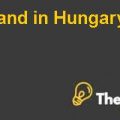
Problem:
Geoff Herzog, The product manager for the development of coffee at Kraft Canada has to decide where to launch the company’s new line of single-serve coffee pods in Canada, the results are encouraging in European market or wait for the results from the United States. If Herzog decides to go ahead with the launch in the Canadian market, he will have to decide a marketing plan, showing the break even by the end year 2006, moreover he will also need a plan for branding and pricing strategy, offering of selected flavors, choice in distribution and a plan for advertising and promotional strategy.
Analysis:
The results of single-server pod machine in Europe are very encouraging, even though there is huge geographical distance in between. Other big coffee brands like Starbucks and Tim Horton have also entered the market of Canada to make a serious breakthrough. The sales of instant coffee in Canada are also declining giving a hint on customers preferring to make coffee themselves and saves cost. However the competition is rising with due to the large-sized discount coffee and the profits and margins are declining. The availability of these SSP which makes coffee very similar to the coffee in Cafes, which are in two types, one is closed system while the other is open. Selling closed systems means the user cannot use any other pod except the one of manufacturer while in open system any pod can be used.
The coffee consumption in Canada is more than any other country in the world, after water the most used beverages are coffee products, 63% people in Canada drink at least one cup of coffee daily, while 55% of those cups are consumed in the breakfast. Kraft directly give it products to the retail partners, who sell the products in their stores, the coffee pod users in Canada are between the ages of 25-54, well educated and have income just below $100,000. Kraft needs to retain good relationships with the retailers, if it decides to go with delivery-to-store system for distribution. Nestle is the biggest competitor of Kraft, with 17% market share while Proctor and Gamble is second with 9% share. The products competing with the Coffee pod are Melitta, Salton and Bunn Home Brewers. Other competitors include Starbucks and Tom Horton, and other beverage suppliers which are alternative drinks to coffee.
Alternative:
Options that are available to Herzog includes to wait for the result of North American launch of Coffee pod, which will show whether it’s a good option to launch coffee pad in Canada. Success of Coffee pod in America will give an idea to Kraft on which customers to focus on, and failure would let Kraft learn from the mistakes before launching it in Canada and only target the customers which will buy the product. Moreover it will also allow Herzog to implement the right distribution, pricing and marketing strategies.
Recommendation:
Herzog needs to take the step and should proceed with the product launch in Canada, without waiting for the results, taking the first step might provide it competitive advantage and capturing the market share. It should target the customers between the ages of 25-54 who are more likely to buy the product. In the start Kraft should focus on quality even if the margin is not high enough, once the product start selling it will have the option to keep more margins on product. Both Nabob and Maxwell products should be launched with an open system pods, where consumers can easily replace the pods. However in a market where profits are already eroding promotion strategy like merchandising should be preferred as it has the ability to save the cost. Rest of the fund can be used on the marketing to targeted customers with more probability to buy the product. Print advertisement is also a viable option for Herzog, as the most coffee people drink is in the morning, when most people also read the papers....................
This is just a sample partial case solution. Please place the order on the website to order your own originally done case solution.













